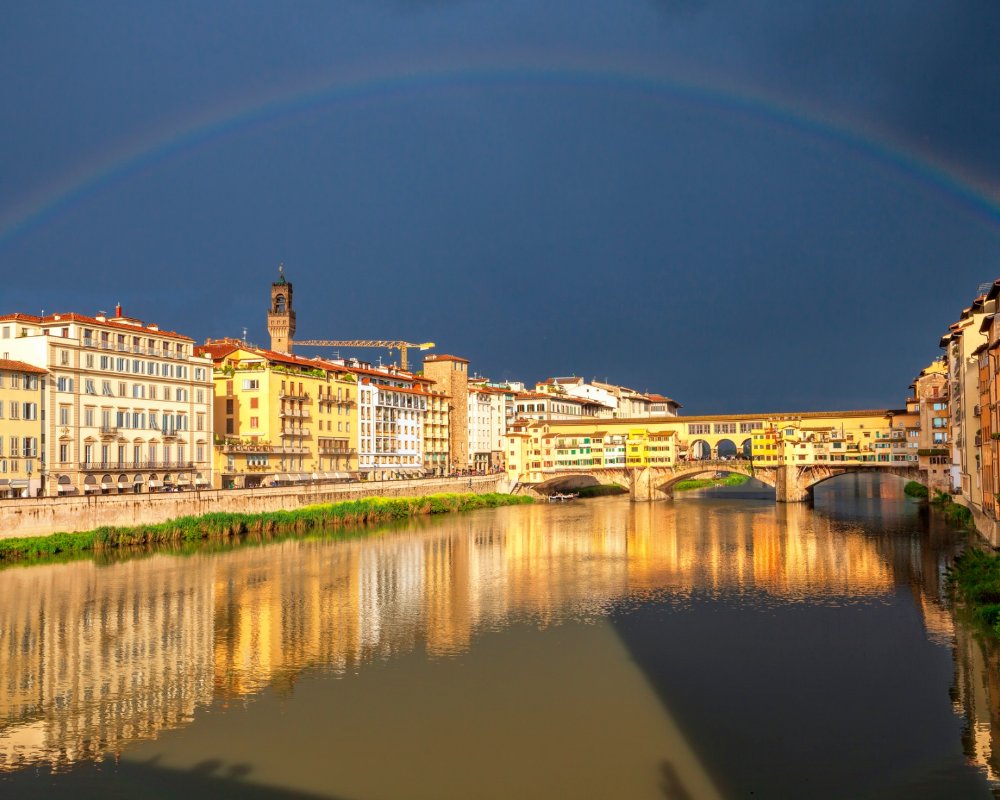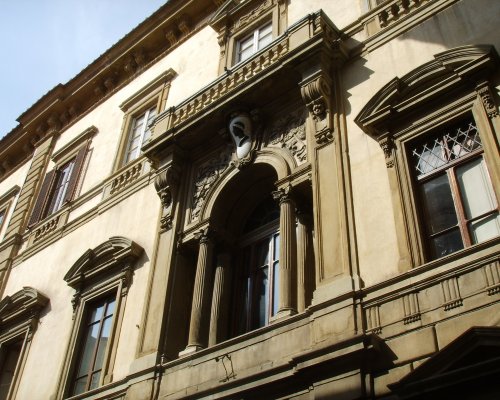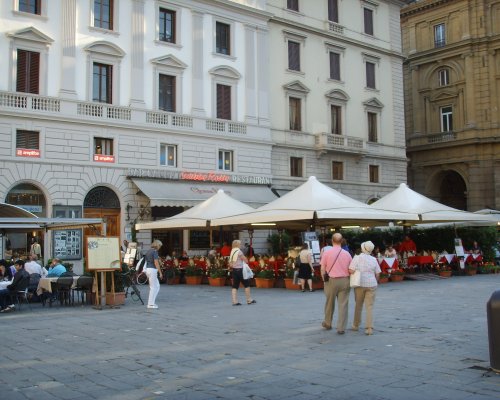A walk through the center to discover rainbow places and stories
There's an endless amount to say about Florence as the city has an infinite number of attractions and itineraries to follow. Here we recommend a walk through the center to discover the unmissable places taking an unusual angle, some less known than others.
We will talk about palace conspiracies, lives, loves and settings such as historic cafes that have united the city and the Italian LGBTQ+ community in the past.
This itinerary is perfect either on foot or by bicycle, accompanied by many interesting stories.
We start our walk from Palazzo Pucci, not far from the Duomo. A beautiful historic building from the first half of the sixteenth century, it was built by the centuries-old Florentine Pucci family. There's a particularly interesting story about one of the Puccis, Pandolfo.
Pandolfo's father, Roberto, played a leading role in the passage of Florence from the Republic to the Principality and this led him to become a key figure for the first Duke Alessandro. Pandolfo, following in his father's footsteps, later became one of the most important court dignitaries of Cosimo I de 'Medici, Alexander's successor. His position, however, did not save him in 1541 from being condemned "for the infamous reason of a disgraceful vice", sodomy, a crime committed with the Florentine sculptor Giovanni Bandini.
The arrest and consequent killing of his father Roberto, guilty of having helped to free his son, aroused anti-Medicean sentiments in Pandolfo, resulting in the conspiracy organized to kill Cosimo de 'Medici, which went down in history as the Pucci conspiracy of 1559. Pandolfo wasidentified as the main "conjurante et instigante" and was then killed on January 2, 1560, hanged from a window in the Bargello.
We start our walk from Palazzo Pucci, not far from the Duomo. A beautiful historic building from the first half of the sixteenth century, it was built by the centuries-old Florentine Pucci family. There's a particularly interesting story about one of the Puccis, Pandolfo.
Pandolfo's father, Roberto, played a leading role in the passage of Florence from the Republic to the Principality and this led him to become a key figure for the first Duke Alessandro. Pandolfo, following in his father's footsteps, later became one of the most important court dignitaries of Cosimo I de 'Medici, Alexander's successor. His position, however, did not save him in 1541 from being condemned "for the infamous reason of a disgraceful vice", sodomy, a crime committed with the Florentine sculptor Giovanni Bandini.
The arrest and consequent killing of his father Roberto, guilty of having helped to free his son, aroused anti-Medicean sentiments in Pandolfo, resulting in the conspiracy organized to kill Cosimo de 'Medici, which went down in history as the Pucci conspiracy of 1559. Pandolfo wasidentified as the main "conjurante et instigante" and was then killed on January 2, 1560, hanged from a window in the Bargello.
We continue our walk to reach Caffè Giubbe Rosse, an important historic café in Piazza della Repubblica.
Founded in 1897, the café was the meeting place of various historical figures such as Carlo Emilio Gadda, Vasco Pratolini and also Aldo Palazzeschi, a Florentine writer and poet who set his novel Interrogatorio alla Contessa Maria here. The protagonist, Countess Maria, is an enigmatic female character described as a devourer of men who some theorize is as a sort of alter ego of Palazzeschi.
We continue our walk to reach Caffè Giubbe Rosse, an important historic café in Piazza della Repubblica.
Founded in 1897, the café was the meeting place of various historical figures such as Carlo Emilio Gadda, Vasco Pratolini and also Aldo Palazzeschi, a Florentine writer and poet who set his novel Interrogatorio alla Contessa Maria here. The protagonist, Countess Maria, is an enigmatic female character described as a devourer of men who some theorize is as a sort of alter ego of Palazzeschi.
We continue to reach Casa Buonarroti on Via Ghibellina, the house-museum where we can admire lesser-known works and the valuable collection of over two hundred autographed drawings by the famous Michelangelo, whose personality, private life and troubled love story is told here.
The idea of creating this building was by Michelangelo Buonarroti the Younger, Michelangelo's great-grandson, who in addition to being a man of letters and a lover of art, published Rime, a collection of Michelangelo's extraordinary poems. In the publication, his great-grandson made the mistake of turning all the adjectives written in the masculine form to the feminine, effectively nullifying the complex life of Michelangelo. He had to wait for the English literary critic John Addington Symondse, one of the first militants, who rediscovered the works and Michelangelo began to be understood as part of the homosexual liberation movement.
We continue to reach Casa Buonarroti on Via Ghibellina, the house-museum where we can admire lesser-known works and the valuable collection of over two hundred autographed drawings by the famous Michelangelo, whose personality, private life and troubled love story is told here.
The idea of creating this building was by Michelangelo Buonarroti the Younger, Michelangelo's great-grandson, who in addition to being a man of letters and a lover of art, published Rime, a collection of Michelangelo's extraordinary poems. In the publication, his great-grandson made the mistake of turning all the adjectives written in the masculine form to the feminine, effectively nullifying the complex life of Michelangelo. He had to wait for the English literary critic John Addington Symondse, one of the first militants, who rediscovered the works and Michelangelo began to be understood as part of the homosexual liberation movement.
After finishing the visit to Michelangelo's house-museum, let's head to the Chiasso del Buco alley to imagine life as it once was.
In this alley in the sixteenth century, you could find the Osteria del Buco, known for being a meeting place for gay men but also characterized by male prostitution.
After finishing the visit to Michelangelo's house-museum, let's head to the Chiasso del Buco alley to imagine life as it once was.
In this alley in the sixteenth century, you could find the Osteria del Buco, known for being a meeting place for gay men but also characterized by male prostitution.
We cross the Arno to reach what was once Tommaso Sgricci's house, in via dei Bardi.
Born in Castiglion Fiorentino (Arezzo) in 1789, Tommaso Sgricci was an Italian poet and actor well known for his improvised poetry. Like contemporary hip hop freestylers, Sgricci was famous for his incredible ability to improvise odes, sonnets or even entire tragedies, simply being inspired by a suggestion from the public.
Sgricci's career had its successes but, as Lord Byron wrote, he was not "remotely respected in Italy" as he deserved.
The reason for this was his homosexuality. Although at the height of his success, it also cost him his expulsion from the Papal States a few days before receiving his poetic coronation at the Capitol.
We cross the Arno to reach what was once Tommaso Sgricci's house, in via dei Bardi.
Born in Castiglion Fiorentino (Arezzo) in 1789, Tommaso Sgricci was an Italian poet and actor well known for his improvised poetry. Like contemporary hip hop freestylers, Sgricci was famous for his incredible ability to improvise odes, sonnets or even entire tragedies, simply being inspired by a suggestion from the public.
Sgricci's career had its successes but, as Lord Byron wrote, he was not "remotely respected in Italy" as he deserved.
The reason for this was his homosexuality. Although at the height of his success, it also cost him his expulsion from the Papal States a few days before receiving his poetic coronation at the Capitol.
We conclude the itinerary in front of Palazzo Pitti, with a visit to the Palatine Gallery which houses works of art that will allow you to discover other aspects of LGBTQ+ culture.
From the painting by Rubens titled George Villiers, Duke of Buckingham, Henry III of France's passion for mignon as portrayed by Francois Clouet housed in the Palazzo Pitti museum, there are many interesting insights into Florentine and European LGBTQ+ life in the past.
We conclude the itinerary in front of Palazzo Pitti, with a visit to the Palatine Gallery which houses works of art that will allow you to discover other aspects of LGBTQ+ culture.
From the painting by Rubens titled George Villiers, Duke of Buckingham, Henry III of France's passion for mignon as portrayed by Francois Clouet housed in the Palazzo Pitti museum, there are many interesting insights into Florentine and European LGBTQ+ life in the past.


